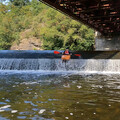These structures are not very widespread and in their time they were built only occasionally.
In the 9th century rotundas were erected on the territory of Great Moravia, and were uncovered during archaeological research in Mikulčice, the Old Town near Uherské Hradiště and also in Znojmo. The oldest rotunda in Bohemia is a church in Budeč dating back to the 10th century, which can be admired in its full glory even today. The youngest rotundas in the Bohemian and Moravian regions are most probably from the late 12th century.
There are currently 49 rotundas registered in these areas. St. Wenceslas Rotunda discovered at Prague’s Lesser Town Square bears the number 16 and is dated to the early 11th century.

In the words of legends
When prince Wenceslas was assassinated in Stará Boleslav, most probably in 935, he was not yet known as Saint Wenceslas. At the time, canonisation required evidence of miracles after death as well as translation of relics. The location of St. Wenceslas Rotunda at the Lesser Town Square in Prague is directly linked with both the translation (the transportation of the saint’s body) to St. Vitus Cathedral at Prague Castle in 938, and a number of miracles that occurred after Wenceslas’ death.
The Wenceslavian legend Ut annuncietur I, dating back to the early 13th century, mentions a place where a miracle associated with St. Wenceslas is said to have taken place in the 10th century. Allegedly, an act of divine intervention occurred by which the prisoners were freed from their shackles and led out of the prison at the exact same moment when a procession accompanying the carriage with the murdered St. Wenceslas was passing it – "in commemoration of this miracle, a church was built in honor of the beatified martyr at the place where the prison once stood, and which stands here to this day."
Booking.com
The mention of the church erected at the place where the miracle had occurred is related to the local St. Wencleslas Rotunda, and is the first written indication of its existence. The Rotunda itself was not built until approximately 150 years after the transfer of the prince’s body and the completion of the legend called Ut annuncietur I.
A stone circle formed of flat marlstone slabs dating back to the times of the translation was discovered under layers of soil. The seemingly small diameter of the stone circle suggests the first Christian structure located at this place, which would also be the oldest church outside Prague Castle.
As time passed by
The rotunda was most likely built as a great parish church serving the core of the original city of Prague. With the passing of time, however, it ceased to fulfill its ecclesiastical purposes. St. Nicholas Church then took up the function of the parish church for the new, early-Gothic city founded by Ottokar II of Bohemia in 1257. At that time, embossed ceramic tiling inside the rotunda was replaced with marlstone blocks. However, part of the original flooring had collapsed leading the stonemasons at the time to merely level this section up and cover it with new marlstone tiles.
Without their knowing they have therefore preserved a piece of heritage that was only discovered some 750 years later.






 VIDEO
VIDEO FACEBOOK
FACEBOOK TWITTER
TWITTER INSTAGRAM
INSTAGRAM PINTEREST
PINTEREST ENGLISH
ENGLISH
















